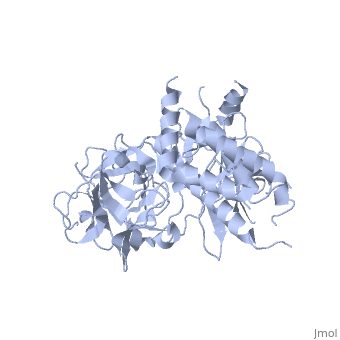2xoa
From Proteopedia
(Difference between revisions)
| (7 intermediate revisions not shown.) | |||
| Line 1: | Line 1: | ||
| - | [[Image:2xoa.png|left|200px]] | ||
| - | + | ==Crystal Structure of the N-terminal three domains of the skeletal muscle Ryanodine Receptor (RyR1)== | |
| + | <StructureSection load='2xoa' size='340' side='right'caption='[[2xoa]], [[Resolution|resolution]] 2.50Å' scene=''> | ||
| + | == Structural highlights == | ||
| + | <table><tr><td colspan='2'>[[2xoa]] is a 1 chain structure with sequence from [https://en.wikipedia.org/wiki/Oryctolagus_cuniculus Oryctolagus cuniculus]. Full crystallographic information is available from [http://oca.weizmann.ac.il/oca-bin/ocashort?id=2XOA OCA]. For a <b>guided tour on the structure components</b> use [https://proteopedia.org/fgij/fg.htm?mol=2XOA FirstGlance]. <br> | ||
| + | </td></tr><tr id='method'><td class="sblockLbl"><b>[[Empirical_models|Method:]]</b></td><td class="sblockDat" id="methodDat">X-ray diffraction, [[Resolution|Resolution]] 2.5Å</td></tr> | ||
| + | <tr id='resources'><td class="sblockLbl"><b>Resources:</b></td><td class="sblockDat"><span class='plainlinks'>[https://proteopedia.org/fgij/fg.htm?mol=2xoa FirstGlance], [http://oca.weizmann.ac.il/oca-bin/ocaids?id=2xoa OCA], [https://pdbe.org/2xoa PDBe], [https://www.rcsb.org/pdb/explore.do?structureId=2xoa RCSB], [https://www.ebi.ac.uk/pdbsum/2xoa PDBsum], [https://prosat.h-its.org/prosat/prosatexe?pdbcode=2xoa ProSAT]</span></td></tr> | ||
| + | </table> | ||
| + | == Function == | ||
| + | [https://www.uniprot.org/uniprot/RYR1_RABIT RYR1_RABIT] Calcium channel that mediates the release of Ca(2+) from the sarcoplasmic reticulum into the cytoplasm and thereby plays a key role in triggering muscle contraction following depolarization of T-tubules. Repeated very high-level exercise increases the open probability of the channel and leads to Ca(2+) leaking into the cytoplasm. Can also mediate the release of Ca(2+) from intracellular stores in neurons, and may thereby promote prolonged Ca(2+) signaling in the brain. Required for normal embryonic development of muscle fibers and skeletal muscle. Required for normal heart morphogenesis, skin development and ossification during embryogenesis (By similarity).<ref>PMID:10388749</ref> <ref>PMID:22036948</ref> | ||
| + | <div style="background-color:#fffaf0;"> | ||
| + | == Publication Abstract from PubMed == | ||
| + | Many physiological events require transient increases in cytosolic Ca(2+) concentrations. Ryanodine receptors (RyRs) are ion channels that govern the release of Ca(2+) from the endoplasmic and sarcoplasmic reticulum. Mutations in RyRs can lead to severe genetic conditions that affect both cardiac and skeletal muscle, but locating the mutated residues in the full-length channel structure has been difficult. Here we show the 2.5 A resolution crystal structure of a region spanning three domains of RyR type 1 (RyR1), encompassing amino acid residues 1-559. The domains interact with each other through a predominantly hydrophilic interface. Docking in RyR1 electron microscopy maps unambiguously places the domains in the cytoplasmic portion of the channel, forming a 240-kDa cytoplasmic vestibule around the four-fold symmetry axis. We pinpoint the exact locations of more than 50 disease-associated mutations in full-length RyR1 and RyR2. The mutations can be classified into three groups: those that destabilize the interfaces between the three amino-terminal domains, disturb the folding of individual domains or affect one of six interfaces with other parts of the receptor. We propose a model whereby the opening of a RyR coincides with allosterically coupled motions within the N-terminal domains. This process can be affected by mutations that target various interfaces within and across subunits. The crystal structure provides a framework to understand the many disease-associated mutations in RyRs that have been studied using functional methods, and will be useful for developing new strategies to modulate RyR function in disease states. | ||
| - | + | The amino-terminal disease hotspot of ryanodine receptors forms a cytoplasmic vestibule.,Tung CC, Lobo PA, Kimlicka L, Van Petegem F Nature. 2010 Nov 3. PMID:21048710<ref>PMID:21048710</ref> | |
| - | + | From MEDLINE®/PubMed®, a database of the U.S. National Library of Medicine.<br> | |
| + | </div> | ||
| + | <div class="pdbe-citations 2xoa" style="background-color:#fffaf0;"></div> | ||
| - | == | + | ==See Also== |
| - | [[ | + | *[[Ryanodine receptor|Ryanodine receptor]] |
| - | + | *[[Ryanodine receptor 3D structures|Ryanodine receptor 3D structures]] | |
| - | == | + | == References == |
| - | < | + | <references/> |
| + | __TOC__ | ||
| + | </StructureSection> | ||
| + | [[Category: Large Structures]] | ||
[[Category: Oryctolagus cuniculus]] | [[Category: Oryctolagus cuniculus]] | ||
| - | [[Category: Kimlicka | + | [[Category: Kimlicka L]] |
| - | [[Category: Lobo | + | [[Category: Lobo PA]] |
| - | + | [[Category: Tung C]] | |
| - | [[Category: Tung | + | [[Category: Van Petegem F]] |
| - | [[Category: | + | |
| - | + | ||
| - | + | ||
| - | + | ||
| - | + | ||
| - | + | ||
Current revision
Crystal Structure of the N-terminal three domains of the skeletal muscle Ryanodine Receptor (RyR1)
| |||||||||||

